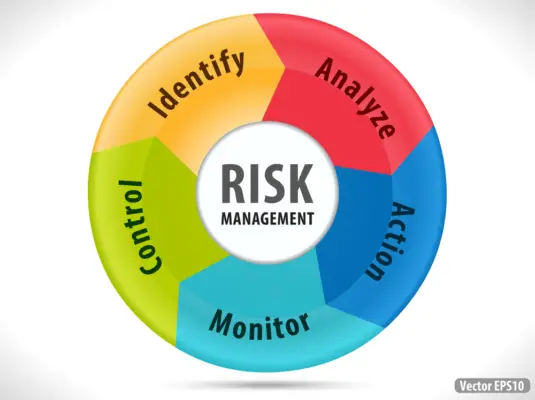Risk in finance is the potential for loss or deviation from expected investment returns. For instance, consider a hypothetical scenario where an investor purchases shares of a technology company expecting high returns due to its innovative products and services.
However, if the company faces unexpected legal issues or fails to secure funding for future projects, it could result in a sharp decline in stock prices and significant losses for investors.
This situation highlights how risk can significantly impact investment outcomes and why it’s important to understand various risk types within the financial world.
In finance, risk refers to the possibility of an investment’s actual return differing from its expected return, including the potential for losing some or all of the original investment. Risk in finance is usually quantified as the standard deviation of return or loss on an investment.
Financial risk is a broad term that can be broken down into various types, each with its own characteristics and areas of impact:
Market Risk: Also known as systematic risk, this is the risk that the value of an investment could decrease due to changes in market factors such as interest rates, commodity prices, foreign exchange rates, or equity prices.
Market risk affects almost all investments and cannot be eliminated through diversification, though it can be managed.
Credit Risk: This is the risk that a borrower may default on any type of debt by failing to make required payments. Credit risk can be associated with a particular individual, company, or country.
Liquidity Risk: This is the risk that an individual or firm will not be able to settle the transaction as planned due to an inability to liquidate assets quickly at a reasonable price. In other words, the risk is that they will be unable to convert assets into cash without a substantial loss in value.
Operational Risk: This refers to the risk of loss resulting from inadequate or failed internal processes, people, and systems or external events. It includes fraud, legal risks, and physical or environmental risks.
Inflation Risk: This is the risk that the value of assets or income will be eroded as inflation shrinks the purchasing power of a currency. Inflation causes money to decrease in value at some predictable rate in the future.
Business Risk: This risk arises from the uncertainty about the profits of a business. Numerous factors influence business risk, including sales volume, per-unit price, input costs, competition, overall market conditions, and government regulations.

Understanding the Concept of Risk in Finance
One of the key elements of this examination process is understanding the different types of risk associated with financial transactions.
These include market, credit, operational, liquidity, and legal and regulatory risks. It is essential to note that each type of hazard affects an investor’s portfolio differently.
For instance, market risks relate to price fluctuations brought about by economic factors such as inflation or recession. Credit risks arise when borrowers fail to repay loans or debts.
Operational risks emerge from internal failures within an organization’s processes or systems. At the same time, liquidity hazards refer to a lack of available cash reserves that may lead to a default on obligations.
Given the significance of these uncertainties in making informed investment decisions, it is vital for financial institutions to always undertake adequate assessments before committing funds.
Risk assessment enables investors’ identification and evaluation of potential threats while highlighting opportunities that can enhance returns on investments.
Therefore, the importance of effective risk management cannot be overemphasized, considering the negative effects of inadequate practices on companies, as seen in Enron’s collapse due to poor handling of its liabilities and accounting manipulations.
Market Risk
Market risk refers to the potential loss arising from changes in market conditions such as interest rates, exchange rates, and stock prices. These fluctuations can cause significant impacts on investments and lead to losses for investors.
To manage market risk, various strategies such as diversification, hedging, and portfolio optimization are used by investors.
Causes and Effects on Investments
Investors face a complex landscape of variables that can shape their investment outcomes, much like a sailor navigating through unpredictable ocean currents and weather patterns on their voyage.
One of the major risks investors face is market risk, which is the possibility of an investment’s value decreasing due to external factors such as economic downturns or geopolitical events.
Market risk is unavoidable for most investments, but investors can manage this risk through various risk management strategies such as diversification and asset allocation.
Additionally, investors should conduct a risk appetite analysis to determine how much market risk they will take based on their financial goals and personal circumstances.
The causes of market risk can vary widely depending on the type of investment in question. For example, stocks may be affected by changes in interest rates or company-specific news such as earnings reports or scandals. Bonds may be affected by changes in credit ratings or inflation expectations.
Regardless of the cause, market risk can have significant effects on investments. In some cases, it can result in substantial losses for investors who did not adequately manage their exposure to this type of risk.
Ways to Manage Market Risk
Implementing effective risk management strategies can provide investors with a sense of security and peace of mind when navigating financial markets’ unpredictable and volatile nature.
One way to manage market risk is through hedging strategies, which involve taking positions that offset potential losses in other investments.
For example, an investor may purchase options on a stock they own as insurance against a potential decline in its value. This allows them to limit their downside risk while maintaining exposure to the upside potential.
Another way to manage market risk is through diversification techniques, which involve spreading investments across different asset classes, sectors, and geographies.
By diversifying their portfolio, investors can reduce their exposure to any one particular investment or market event. For instance, an investor may hold stocks from various industries, such as technology, healthcare, and consumer goods, instead of just investing in one sector.
Additionally, they may allocate some portion of their portfolio towards bonds or real estate investment trusts (REITs) for added diversification benefits.
Implementing these risk management strategies can help investors achieve better long-term returns while minimizing the impact of short-term market fluctuations on their portfolios.
Credit Risk
Assessing the likelihood of default on a loan or bond is a crucial aspect of credit risk analysis in financial markets. Credit risk refers to the possibility that a borrower will fail to make timely payments or default on their debt obligations.
It is an important consideration for lenders, investors, and bondholders exposed to potential losses if borrowers do not repay as agreed.
Probability assessment is an essential tool for managing credit risk. To assess the probability of default, analysts use historical data to calculate default rates and estimate the likelihood of future defaults.
Other factors influencing credit risk include economic conditions, industry trends, and company-specific information such as financial statements and credit ratings. By analyzing these factors, analysts can determine whether a borrower will likely default on their debt obligations.
One way that lenders and investors manage credit risk is by diversifying their portfolios. This involves spreading investments across multiple borrowers or companies in different industries with varying levels of credit risk.
Diversification can help reduce overall portfolio risk by minimizing exposure to any one borrower or industry.
Additionally, lenders may require collateral or guarantees from borrowers as a form of security against potential losses due to defaults. Effective credit risk management requires ongoing monitoring and analysis of market conditions and individual borrowers’ financial health.

Operational Risk
Operational risk, a lesser-known type of risk in financial markets, poses a significant threat to the stability and profitability of financial institutions due to its potential to cause operational failures that can lead to reputational damage, financial losses, and regulatory fines.
Operational risk refers to the risks arising from inadequate or failed internal processes, people, systems or external events.
In today’s world, where process automation is gaining momentum and cyber threats are becoming more sophisticated, financial institutions must be aware of their operational risks and develop robust strategies for managing them.
Financial institutions use various risk assessment techniques, such as historical loss data analysis and scenario analysis, to mitigate operational risk effectively.
Historical loss data analysis involves studying past incidents of operational failure within an institution to identify patterns and trends that can help predict future losses.
Scenario analysis involves creating hypothetical situations that could lead to operational failure and analyzing how they would impact the institution. Such techniques enable the identification of high-risk areas within an organization and aid in developing effective control measures before an incident occurs.
Given the potential consequences of operational failures on financial institutions’ reputation and bottom line, it becomes imperative for organizations to prioritize their efforts towards mitigating this type of risk adequately.
Organizations can proactively manage their operational risks through regular assessments utilizing appropriate techniques like historical loss data analysis or scenario analysis coupled with continuous monitoring of their operations using various tools like process mapping software or key performance indicators (KPIs).
Managing and Mitigating Risk
Effective management and mitigating potential threats are crucial for financial institutions’ stability and long-term profitability.
Identifying vulnerabilities in a timely manner can help organizations take proactive measures to minimize risk exposure.
Financial institutions use risk assessment techniques to evaluate and prioritise potential risks based on their impact on the organization’s operations.
One commonly used technique for managing risk is diversification, which involves investing in different asset classes with a low correlation. This approach helps reduce the overall risk exposure of an institution by spreading out investments across multiple areas.
Another strategy is hedging, which involves taking positions that offset potential losses from adverse price movements or market fluctuations.
In addition to these strategies, effective management and mitigation of risk also involve implementing robust control mechanisms such as internal audits, regular stress testing, and scenario analysis.
These tools help identify any gaps in existing systems and processes that may expose an organization to increased risk levels.
Constantly monitoring their operations for potential threats and implementing appropriate controls, financial institutions can safeguard their assets while achieving long-term profitability goals without compromising quality standards or customer satisfaction levels.
Frequently Asked Questions
How does risk management differ in the context of different financial institutions, such as banks versus insurance companies?
Risk management strategies and risk assessment techniques differ significantly depending on the type of financial institution.
For instance, banks have to deal with credit risk, which arises from the possibility of borrowers defaulting on their loans. To manage this risk, banks use various techniques, such as diversifying their loan portfolios and setting up reserves to cover potential losses.
On the other hand, insurance companies face risks associated with underwriting and investment activities. They mitigate these risks using sophisticated actuarial models to calculate premiums and closely monitor claims.
Overall, while both banks and insurance companies manage risk, they employ different methodologies to achieve their objectives based on their unique business models and regulatory requirements.
Can risk ever be eliminated in finance, or is it always present to some degree?
Risk mitigation strategies have been an integral part of financial institutions for decades. These strategies are designed to identify, assess and manage risks associated with various financial activities.
However, it is widely accepted that risk can never be eliminated in finance, as uncertainty and unpredictability will always be inherent in any financial transaction.
With the advent of technology, risk management practices have undergone significant changes. Advanced analytical tools and algorithms have enabled firms to automate many aspects of their risk management processes, thus improving efficiency and accuracy.
Nonetheless, technological advancements have also given rise to new forms of risk, such as cyber threats and data breaches, highlighting the need for continued innovation in risk management practices.
How do global economic events, such as recessions or political upheavals, impact the level of risk in financial markets?
Global economic events, such as recessions or political upheavals, significantly impact the level of risk in financial markets.
A recession can lead to decreased consumer spending and reduced business activity, which can cause company bankruptcies and a decrease in stock values.
Political upheavals can cause market instability by creating uncertainty about government policies and international relations.
These events can increase the volatility of financial markets, leading to increased risk for investors.
Thus, it is important for investors to carefully consider the impact of global economic events when making investment decisions and to diversify their portfolios to minimize risk exposure.
What role do government regulations and regulatory bodies play in managing risk in finance?
Government regulations and regulatory bodies play a crucial role in managing risk in finance. In fact, without these measures, the financial system would be vulnerable to various types of risks that could lead to economic instability.
The government establishes rules and guidelines that promote transparency, accountability, and fairness in financial transactions. Regulatory bodies are responsible for enforcing these rules and monitoring compliance with them.
How do investors and traders assess and quantify risk when making investment decisions?
Investors and traders use various analytical tools and models to assess and quantify risk when making investment decisions.
Quantifying risk involves measuring the probability of an adverse event occurring and the potential impact of that event on an investment portfolio.
Risk tolerance, which refers to an investor’s ability to withstand fluctuations in the value of their investments, is also considered when assessing risk.
Statistical analysis, such as standard deviation or beta coefficients, is a common method used to measure risk.
Other techniques include stress testing, scenario analysis, and Monte Carlo simulations.

Conclusion
Risk is a fundamental financial concept that refers to the possibility of losses or negative outcomes resulting from investment decisions. Three main types of risk exist in finance: market risk, credit risk, and operational risk.
Market risk is the uncertainty associated with fluctuations in financial markets, while credit risk relates to the possibility of default by borrowers. Operational risk arises from internal factors such as human error, system failures, and fraud.
Effective management and mitigation of risks are essential for businesses and individuals seeking to achieve their financial goals. Various techniques can be used to manage risks, including diversification, hedging, and insurance.
In addition to these traditional methods, technological advancements have developed sophisticated tools for identifying and managing risks.
Interestingly, a study conducted by the Global Risk Management Survey in 2020 on over 200 global corporations across different industries ranging from healthcare to financial services shows that cybersecurity remains one of the top five risks organisations face globally.
The study revealed that about 40% of respondents identified cyber threats as one of their most pressing concerns due to their potential impact on business operations and reputation. This statistic underscores the importance of addressing cybersecurity risks through appropriate measures, such as investing in advanced security systems and employee training programs.
Understanding different types of risks is crucial in making sound investment decisions in finance. Effective management strategies can mitigate these risks while enhancing returns on investment portfolios.
Finally, individuals and businesses need to recognize emerging trends like cybersecurity which is becoming increasingly critical due to its potential impact on business operations and reputation worldwide.

Chris Ekai is a Risk Management expert with over 10 years of experience in the field. He has a Master’s(MSc) degree in Risk Management from University of Portsmouth and is a CPA and Finance professional. He currently works as a Content Manager at Risk Publishing, writing about Enterprise Risk Management, Business Continuity Management and Project Management.

